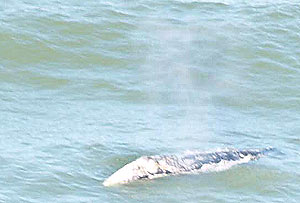Oregon Coast Officials: Still Plenty of Whales This Month
Published 01/06/2016 at 4:33 PM PDT
By Oregon Coast Beach Connection staff

(Oregon Coast) – Oregon officials are anxious to point out that Whale Watch Week may be over, but the peak migration of Gray whales is not. You can still see plenty of them for at least the next week, as the peak generally runs into the middle of January. It then starts to taper off and by the first week of February they are gone – until March. (Photo above courtesy Seaside Aquarium: a mother Gray whale and her calf).
As many as 30 per hour may still be wandering past these shores.
How to see a whale? Oregon Department of Fish and Wildlife (ODFW) said head out to the Oregon coast on a calm day and find a high viewpoint. These include Neahkahnie Mountain near Manzanita, Cape Foulweather near Depoe Bay, Ecola State Park at Cannon Beach or the Cape Perpetua Visitors Center near Yachats – to name a few. You'll want to look out a few miles beyond shore.
“Learning good binocular technique will help spot the whales,” ODFW said. “Gaze out onto the ocean, focusing on medium distances until you see a puff of white. Then raise your binoculars while continuing to look at the place you saw the puff. This technique takes some practice, but generally works better than swinging the binoculars around looking for something. Just keep your eyes focused on the whale and raise the binoculars to your eyes, looking through them, not into them.”
Most whales are one to five miles offshore. If you're lucky, you may see them lingering in one area as they graze on plankton and mysid shrimp. The Depoe Bay area is a particularly popular feeding spot for them, and a handful of tour boat businesses operate out of there to give you some stunning, close-up experiences with them. The seawall and the Whale Watch Center in town offer up fine views as well.
 Coastal storms can make whale watching difficult with wind and waves obscuring signs of the gray whale migration. Days with large wave action are great for watching the breakers go bonkers, but not so good for whales. (Photo at right by Tiffany Boothe, Seaside Aquarium).
Coastal storms can make whale watching difficult with wind and waves obscuring signs of the gray whale migration. Days with large wave action are great for watching the breakers go bonkers, but not so good for whales. (Photo at right by Tiffany Boothe, Seaside Aquarium).
One of the more spectacular experiences is being close enough to hear a whale blow air through the top of its body.
“A gray whale's blow is up to 15 feet high, and each blow is visible for about five seconds,” ODFW said. “When warm, moist air exhaled from the animals' lungs, meets the cool air at the ocean surface, it creates the bushy column called a blow, or spout. Anticipate that the whale will dive for three to six minutes, then surface for three to five blows in row, 30 to 50 seconds apart, before diving deep for three to six minutes again.”
Recent tagging studies by Oregon State University scientists show that most gray whales only stay about three weeks in the warm waters off Baja, Mexico. Then they head back to the cold, but plankton-rich waters of the north Pacific. The exception is mothers and calves, which stay on the breeding grounds between two and three months. Oregon Coast Hotels for this - Where to eat - Maps - Virtual Tours
More about Oregon Coast Whales.


Above: whale in Rockaway Beach, courtesy Patt Berry. Below: whales by satellite.



More About Oregon Coast hotels, lodging.....
More About Oregon Coast Restaurants, Dining.....
Cannon Beach Lodging
Nehalem Bay Lodgings
Manzanita Hotels, Lodging
Three Capes Lodging
Pacific City Hotels, Lodging
Lincoln City Lodging
Depoe Bay Lodging
Newport Lodging
Waldport Lodging
Yachats Lodging
Oregon Coast Vacation Rentals
Oregon Coast Lodging Specials
LATEST Related Oregon Coast Articles
Likely just before dawn best hour but peak happens during daylight. Weather
Dark Sky Week is Prime Along Oregon Coast: Where and Where Not to Go
General guide to dark sky viewing from south to north coast. Astronomy
Sizable Price Drop, Deals in Lincoln City During Quiet of April on Central Or...
20 perc off at A1 Vacation Rentals across its roster, including Gleneden Beach. Lincoln City specials
Upcoming S. Oregon Coast Events Include Gem Show, History: Coos Bay, Bandon
May 6 talk at Coos History Museum, Mayfly Fest May 17, Bandon Rock / Gem Show June 7,8
Washington Coast Cleanup on April 19 - Coinciding with Oregon Coast's SOLVE E...
From the Puget Sound to Long Beach, alongside Oregon's cleanup. Washington coast events, Seaside events
Astoria's Riverwalk Gets New Lighting, More N. Oregon Coast Roadwork
Delays coming this summer, but the riverwalk has a new look. Seaside, Cannn Beach
April Gets Even Cheaper Midweek at Depoe Bay, Lincoln City: Oregon Coast Deals
Off-season rates plus more at Keystone Vacation Rentals. Depoe Bay lodging specials, Lincoln City hotel reviews, Newport hotel reviews
Washington Coast Begins Week of Clam Digs, April 12 Through 18
Long Beach, Twin Harbors, Mocrocks and Copalis at different times. Washington coast events
Back to Oregon Coast
Contact Advertise on BeachConnection.net
All Content, unless otherwise attributed, copyright BeachConnection.net Unauthorized use or publication is not permitted














































